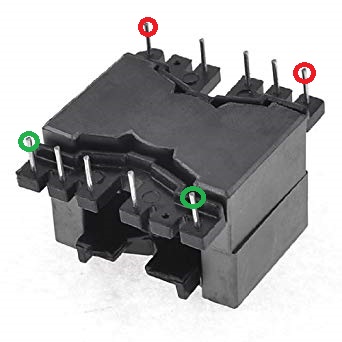First of all, I really searched the topic on both EE.SE and Internet but could find nothing. If this is asked before, please forgive me.
As I stated here earlier, I was working on an HV amplifier. We built the circuit but before testing it with the output transformer I first wanted to measure the insulation resistance of the transformer.
The guys have wound the transformer's primary and secondary across the marked pins below (i.e. primary across the red ones and the secondary across the green ones):
Measuring method: Descibed in the picture below:

simulate this circuit – Schematic created using CircuitLab
METER is a device consisting of a variac and an adjustable current threshold. If the measured current is close to the threshold then a warning lamp lights up. If the measured current exceeds the threshold then METER activates its breaker. So we rate the insulation voltage as the maximum voltage before the failure.
According to the method above with 5mA current threshold, the insulation voltage of the transformer was about 1kV which is quite low to me. Because I want it to be at least 2kV.
One of the collegues told me that it's due to the low distance between pins and the core. So I moved the windings start and stop pins to 3-4 and 9-10, respectively, which have higher distance to the core. After that modification, I measured the insulation voltage as 1.5kV.
I cannot explain this! How is this even possible? If it was an iron-powder core then I could explain this, because it contains "iron". But this is soft ferrite (MnZn - Manganese and Zinc) and it does not contain any "conductive" materials, doesn't it? Can high voltage really jump through the ferrite?

